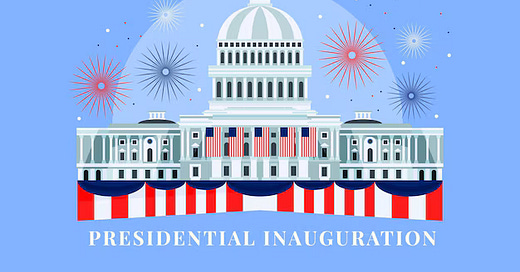Inauguration is the process of swearing the newly elected president into office for the next 4-year term thus making that person the incumbent president of the United States. The president-elect is inaugurated by taking the presidential oath of office then engaging in parades and other festivities throughout the day.
The History of Inauguration
The word inauguration stems from the Latin ‘augur”, which refers to rituals of ancient Roman priests. These priests were usually seeking to interpret if it was the will of gods for a public official to be deemed worthy to assume office. Such an inauguration commonly occurs through a formal ceremony as well as an inaugural address by the new official.
George Washington was inaugurated in two different cities.
George Washington had to borrow money to attend his first inauguration.
George Washington started the tradition of using a Bible in 1789.
George Washington started the inaugural address tradition.
George Washington started the tradition of adding “So help me God” at the oath’s end.
None of John Adams's family members were present for his inauguration.
John Adams was the first president to skip his successor’s inauguration.
Thomas Jefferson walked to and from his first inauguration.
Date for Presidential Inaugurations
Inaugurations used to happen in March.
The 20th Amendment moved the Inauguration Day to January 20
Between 73 and 79 days after the presidential election, the president-elect of the United States is inaugurated president.
The first inauguration of George Washington took place on April 30, 1789 but all subsequent public inaugurations from 1793 until 1933 were held on March 4, except in 1821, 1849, 1877, and 1917, when March 4 fell on a Sunday and the public inauguration ceremony took place on Monday, March 5.
Since 1937, Inauguration has taken place at noon EST on January 20, except in 1957, 1985, and 2013, when January 20 fell on a Sunday. Then the presidential oath of office was administered on that day privately and then in a public ceremony on Monday, January 21.
Location for the Inauguration
From 1829 through 1977, most swearing-in ceremonies had taken place on a platform over the steps at the Capitol’s east portico. They have also been held inside the Old Senate Chamber, the chamber of the House of Representatives, and the Capitol rotunda.
Since the1981 inauguration of Ronald Reagan, the ceremony has been held at the west front of the United States Capitol facing the National Mall with its iconic Washington Monument and distant Lincoln Memorial.
The fourth inauguration of Franklin D. Roosevelt in 1945 was held at the White House.
The 1817 inauguration of James Monroe was scheduled for the House chamber, but after a disagreement broke out between the House and Senate about whose chairs would be used, Monroe had enough and decided to take the oath of office and deliver his speech outdoors.
The Process of Taking the Oath
Article II, Section 1 of the Constitution spells out the presidential oath: "I do solemnly swear (or affirm) that I will faithfully execute the Office of President of the United States, and will to the best of my ability, preserve, protect and defend the Constitution of the United States."
John Quincy Adams didn’t take his oath on a Bible but rather on a law book containing the Constitution.
Chief Justice usually administers the inaugural oath except for when there is an urgent need like the sudden death of a sitting President.
Federal Judge Sarah T. Hughes in 1963 administered the inaugural oath after President Kennedy’s death.
Little-Known Facts of Inaugurations
A month after William Henry Harrison spent two hours delivering his 8,445-word inaugural address in 1841, the 68-year-old president was dead from pneumonia, perhaps due to his prolonged exposure to raw, blustery elements during the inaugural.
The shortest addresses given were from George Washington at 135 words in his second address, Franklin Roosevelt at 559 words in his fourth address and Abraham Lincoln 701 words in his second address.
When Andrew Jackson was inaugurated for his first term in 1829, he welcomed a rowdy crowd of 20,000 of his supporters to celebrate with him, a celebration which dissolved into a near-brawl with broken furniture and smashed crystal, ladies fainting and men with bloody noses. Jackson was forced to escape the mayhem by jumping through a window.
The day of Ulysses S. Grant’s second inauguration in March 1873 was one of the coldest March days in the history of Washington, D.C. The recorded temperature was 16˚F at noon, with gusty winds making it feel more like -15° to -30°F. Flags along Pennsylvania Avenue froze or were ripped loose, while ambulances stood by during the inaugural parade to take frostbitten military cadets to the hospital.
During the inauguration of Dwight D. Eisenhwer in 1953, he broke with tradition by reciting his own improvised prayer after taking the oath, rather than kissing the Bible. He then presided over an inaugural parade that featured some 62 bands and 26,000 participants. With permission from the Secret Service, a California cowboy and trick roper named Montie Montana lassoed the new president, as a grinning Vice President Richard Nixon, among other dignitaries, looked on.
After taking his oath in a $175 suit purchased a week earlier in his home state of Georgia, Jimmy Carter surprised spectators when he and his family emerged from the presidential limousine to walk at the head of his inaugural parade in January 1977. The only other president to do so up to that time had been Thomas Jefferson, on his first inauguration day in 1803.
=========================================================================
My Book Store
On Track for Success in Finances by Sharon O'Maley | eBook | Barnes & Noble® (barnesandnoble.com)
Lift Off with Financial Investments by Sharon O'Maley | eBook | Barnes & Noble® (barnesandnoble.com)
Best DIY Brand Showcase



